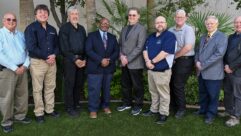 The recently published book “Radio’s Second Century: Past, Present and Future Perspectives” is an academic survey of our industry, a collection of essays, statistics, graphs and antidotes edited by author and professor John Allen Hendricks that features contributions from scholars in media and journalism.
The recently published book “Radio’s Second Century: Past, Present and Future Perspectives” is an academic survey of our industry, a collection of essays, statistics, graphs and antidotes edited by author and professor John Allen Hendricks that features contributions from scholars in media and journalism.
Hendricks is department chair and professor of mass communication at Stephen F. Austin State University in Nacogdoches, Texas, and author or editor of 11 books.
This one is a collection that belongs on the shelf labeled “media studies.”
Promotional information for the book notes that as the industry enters its second century, it continues to be a dominant mass medium even in the face of competition.
“Lasting influences such as on-air personalities, audience behavior, fan relationships and localism are analyzed [in the book], as well as contemporary issues including social and digital media,” it states.
“Other essays examine the regulatory concerns that continue to exist for public radio, commercial radio and community radio, and discuss the hindrances and challenges posed by government regulation with an emphasis on both American and international perspectives. Radio’s impact on cultural hegemony through creative programming content in the areas of religion, ethnic inclusivity and gender parity is also explored.”
Michael Brown writes in the forward that the book “points to a diverse and open field for those who wish to study radio and those who have an interest in learning what we know about the technology, programming, social issues and international use of radio.”
Academic text

To give you a further idea of its content mix, Part I is titled “Contemporary Radio: Social and Digital Media.”
This section includes discussions about listening “from AM to FM to XM, and beyond”; audience research and web features in radio; the “para-social” nature of podcasting; and social media analytics.
Part 2 explores “Programming Matters: Localism, Personalities and Audiences.” Chapters focus on “the shrinking electronic town square” and localism in talk radio; the fandom of Howard Stern; lessons from the “War of the Worlds” broadcast; and how to encourage creative programming.
Part 3, “Social Issues,” includes chapters on religion in radio, NPR’s role in America and “resisting podcasting’s sonic whiteness,” while Part 4 takes on international perspectives including community/campus radio in Canada, the dominance of public radio in podcasting and the role of women in radio.
Among discussions I found interesting are ones focusing on radio as “theater of the mind”; how NPR aspires to create “driveway moments” through storytelling; how radio and podcast producers use sound to create a feeling of intimacy and connection; and how using headphones changes the listening experience.
The book would be an excellent read for a college student pursuing a degree in communications or journalism and needing insight into the radio industry. It’s also suitable for those who like to think hard about the roles that radio and audio play in our culture and how people interact with them.
This isn’t a book for those who want to know how to sell more radio spots or learn about the next technology platform that will change our industry. In general I found that it does not offer much in the way of definitive direction and improvement; a reader is left to conclude what direction radio should take in the next century. The stats and graphs can get repetitive, causing one to want to skim ahead.
However a strength of the book is its exploration of podcasting. It breaks down the success and appeal of the new medium and why it has such dominance with radio listeners:
I enjoyed passages about podcasting as a “converged medium” that brings together audio, the web and portable media devices, as well as a disruptive technology that has forced some in radio to reconsider established practices. I think the book is spot-on in its conclusion that podcasting will continue to dominate and be a strong substitute for listeners seeking news, information and entertainment.
The book is published by Rutgers University Press and retails for $39.95 in its paperback version.
The author is a project engineer at Lawo North America.










